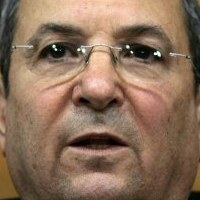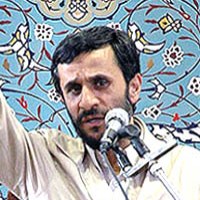![]()
Tue, June 07, 2011 | Rubin Reports | By Barry Rubin
How A New York Times Article Tells You Everything You Need to Know About the Israel-Palestinian Conflict By Being Full of False Information
I don’t mean to keep picking on the New York Times but the problem is that the New York Times keeps picking on Israel. As usual, I have saved the truly funny treat for the end.
Actually, this is a pretty good article by the usual standards because it is so determined to be “even-handed.” On the one hand, there is Israel, a democratic state with a free media (that often criticizes the government) and that has video tape of the incident in question.
On the other hand, there is Syria, a dictatorship that censors all the news, controls all of the media, and is currently involved in murdering hundreds of its citizens. Incidentally, we could produce a dossier of past Syrian claims regarding the United States to measure the accuracy of its media and government’s assertions on this issue.
How is a poor newspaper supposed to determine their relative credibility?
Here’s how the article starts:
“Israeli military officials disputed Monday the casualty figures announced by Syria a day earlier, after Israeli forces fired on protesters who had tried to breach the Syrian frontier with the Israeli-held Golan Heights, the discrepancy in numbers underlining the messages being conveyed by both sides.”
“According to the Syrian version of events, Israel shot to kill unarmed demonstrators who were trying to reclaim their lost lands — whether in the Golan Heights, which Israel captured from Syria in the 1967 Middle East war, or in historic Palestine.”
“But Israel said that the Assad government in Syria was exploiting the Palestinian issue by sending unarmed protesters to the frontier in order to divert attention from its own antigovernment uprising and the bloody attempts to put it down.”
(Update: After the article came out, the U.S. State Department officially corraborated Israel’s position as accurate.)
Let’s give an incomplete list of what isn’t mentioned:
— Notice how in paragraph one we are told they are just “protesters” while in paragraph two we are told they are “unarmed protesters” and in paragraph three we are again told they are “unarmed protesters” in case we didn’t get that point in paragraph two.
The fact that Israel has said they carried molotov cocktails and that they set off land mines (that’s the kind of thing that happens when “unarmed protesters” run through minefields) — thus causing the casualties — isn’t mentioned here though it is in paragraph ten. Incidentally, why should we believe the Israeli assertions in paragraph ten when the reporter (and the New York Times is always totally accurate as the new executive editor tells us, right?) has already told us that it isn’t true in paragraphs one, two, and three.
— In paragraph two we are told the protesters “were trying to reclaim their lost lands — whether in the Golan Heights, which Israel captured from Syria in the 1967 Middle East war, or in historic Palestine.” Reclaim their lost lands? How could anyone not sympathize with that. But wait! Are you saying that the purpose of this demonstration was only about the Golan Heights? Because there’s a difference. Most readers presumably think that “historic Palestine” means the West Bank and the Gaza Strip. Of course it means wiping Israel off the map entirely.
And why “historic Palestine?” Why not the historic Land of Israel? Or in Israel? The article’s phrasing, too, slants the readers’ perception, right? They just want to redeem their lost lands in Palestine that Israel stole? So the destruction of Israel is portrayed as the Palestinians merely wanting to get their lost lands back.
Yet, of course, this raises the all-important issue of whether we are dealing here with the demand for two states living at peace side by side or wiping Israel off the map and commiting genocide against its Jewish population. The demonstrations bring out that key question, while the article buries it or makes the Palestinian demand for “return” seem quite reasonable.
— We are told that the Syrians say that Israeli forces shot to kill but we are not told what Israelis say they did. The video of the announcement to the demonstrators — warning them not to advance and practically pleading with them not to do so — is available. But there is no hint of that in the article.
— Why are we told that Israeli officials said the Syrians sent out “unarmed” protesters when in fact it said that the protesters were armed with molotov cocktails, which is a weapon? Obviously, Israeli officials didn’t say that.
But here’s the all-important phrase that led me to write this article: “the discrepancy in numbers underlining the messages being conveyed by both sides.” I understand the idea behind writing that phrase, and there is something to it. But what shocked me is that the question of what is the truth is transformed into a mere question of propaganda battles. I’ll bet that Israel is telling the truth and Syria isn’t. What should be happening is an attempt to get at which account is true. Yet that view of truth as purely relative, as “constructed” based on “narrative” is one of the main intellectual horrors of the contemporary era that has led to incredible damage being done on academia and the media.
Imagine this being written by some newspaper somewhere in the Middle East:
U.S. officials say that a radical Islamist group hijacked airplanes and flew two of them into the World Trade Center, killing over 3000 people. According to the Syrian version of events, the fall of the World Trade Center was a U.S. government-Zionist plot, the discrepancy in accounts underlining the messages being conveyed by both sides.
That’s the kind of international media environment Israel must deal with daily.
But I promised you a treat so here it is. Remember that I said a key issue buried by the article is whether Israel’s enemies and neighbors want a two-state solution resulting in real peace or Israel’s destruction altogether? Well here’s the article’s priceless statement:
“Huda Tumeizi, a young woman from the West Bank city of Haifa, marched toward the Qalandia checkpoint, on the edge of Jerusalem, holding a placard that read: “I am going back to Haifa.”
So in other words, when Palestinians say that they want Haifa under their rule they are just talking about a West Bank-Gaza state in the context, right? But actually Haifa is not on the West Bank. It is one of Israel’s largest cities. So when Tumeizi says she’s going to Haifa she means, over Israel’s dead body.
But there’s more!
I did one minute of research and, behold, there’s a story behind the story on Ms. Tumeizi. She didn’t think up that slogan all by herself. You see, just a few days prior to the demonstration a women’s center in the Al-Far’a refugee camp opened a camp for children called “Going to Haifa,” where chilrden were told that they should demand such a return.
Why should they expect to be able to go back? Well, Yasser Abu Kishk, who seems to be the leader of the camp’s council, told the children that the Arab revolutions and Hamas-Fatah reconciliation were bringing the day of the realization of the right of return closer. In other words, forget about the resettlement of refugees in the new state of Palestine and forget about any agreement with Israel because the Palestinians are going to achieve complete victory. Why? Because the new Arab revolutionary governments will fight Israel, and Hamas and Fatah will fight together to get everything.
Thus, this little story shows us that the peace process isn’t going to work and that no matter how many concessions Israel makes it won’t arrive at peace.
I presume that Mr. Abu Kishk is a Fatah member who was put in his job by the Palestinian Authority. I would also bet that what he did and the organization of this project went on in many other refugee camps on the West Bank. I also wouldn’t be surprised if this was all paid for by international donors who are very pleased with themselves at helping to establish a women’s center in a refugee camp as a humanitarian contribution to the improved status of Palestinian women and the advance of the region to peace.
By the way, I’m sure the Haifa mistake did not come from the correspondent. Presumably, she just wrote the word Haifa and someone on the Times editing desk thought that its location should be further identified for readers. The problem then is that the people editing articles don’t knowt hat Haifa is in Israel. A subtext here is the assumption that the Palestinians only want a two-state solution so if they want it that place must be in the West Bank.
Later, the Times changed Haifa to Hebron and said that is where she came from. I don’t believe it. And of course once again they didn’t ask the obvious question: Why can’t she go back to Hebron? Unless involved in terrorism a Palestinian from Hebron, 80 percent of which is ruled by the PA, could certainly apply to go there. I believe that this correction is just not…correct.
Now, this very quickly descends to madness. Here’s the official British statement on the incident issued by Foreign Secretary William Hague under the headline, “Foreign Secretary concerned by reports of protesters killed in Golan Heights”:
“I am deeply concerned by reports that a number of protesters have been killed and others injured following protests in the Golan Heights yesterday. We recognise Israel’s right to defend herself. It is vital that any response is proportionate, avoiding lethal use of force unless absolutely necessary, and that the right to protest is respected. I continue to call on all parties, including the Governments of Israel and Syria, to do everything they can to protect the lives of civilians and to avoid provocative acts.”
In other words, if hundreds of militant protestors organized by a dictatorial regime that wants to wipe out its neighbor attack a country’s border armed with molotov cocktails and try to tear down the border defenses and ignore warnings to stop then both sides are at fault and “the right to protest” must be respected by Israel.
I’d have preferred the headline “Foreign Secretary concerned by reports of militant advocates of genocide against Israel attack an ally,” but, hey, that’s just me.
I doubt whether anyone will look at such articles with the detail I do. One reader asked, understandably, why I keep writing about the silliness of the mass media. The answer (aside from there’s so much of it) is the following:
— It is putting forward a view of Middle Eastern history and reality that is totally misleading. That view largely coincides what the “narrative” of academics and many government officials. It must be defined and understood.
— Many people are still unaware of the indoctrination in the media. It was tolerable when the news was only being slanted. Now it is intolerable as the news is being completely distorted.
— In the process of explaining how the coverage is wrong, it is possible to lay out the realities. One of the more amusing ways of doing this is to show how the media often gives you the information you need buried or misrepresented in their own texts.
So here’s my proposal: the New York Times covers the Middle East better so I don’t have to write any more articles like that. Deal?
About the author,
Barry Rubin is director of the Global Research in International Affairs (GLORIA) Center, editor of the Middle East Review of International Affairs (MERIA) Journal, and a featured columnist at PajamasMedia http://pajamasmedia.com/barryrubin/ His latest books are The Israel-Arab Reader (seventh edition), The Long War for Freedom: The Arab Struggle for Democracy in the Middle East (Wiley), and The Truth About Syria (Palgrave-Macmillan). The website of the GLORIA Center is http://www.gloria-center.org. His PajamaMedia columns are mirrored and other articles available at http://www.rubinreports.blogspot.com/.



 RSS
RSS












NYT Article Tells You Everything You Need to Know About the Israel-Palestinian Issue By Being Full of False Information | http://j.mp/kSctp4
NYT Article Tells You Everything You Need to Know About the Israel-Palestinian Issue By Being Full of False Information | http://j.mp/kSctp4
How A New York Times Article Tells You Everything You Need to Know About the Israel-Palestinian Conf http://fb.me/10Ni9X0Zl
How A New York Times Article Tells You Everything You Need to Know About the Israel-Palestinian Conf http://fb.me/10Ni9X0Zl